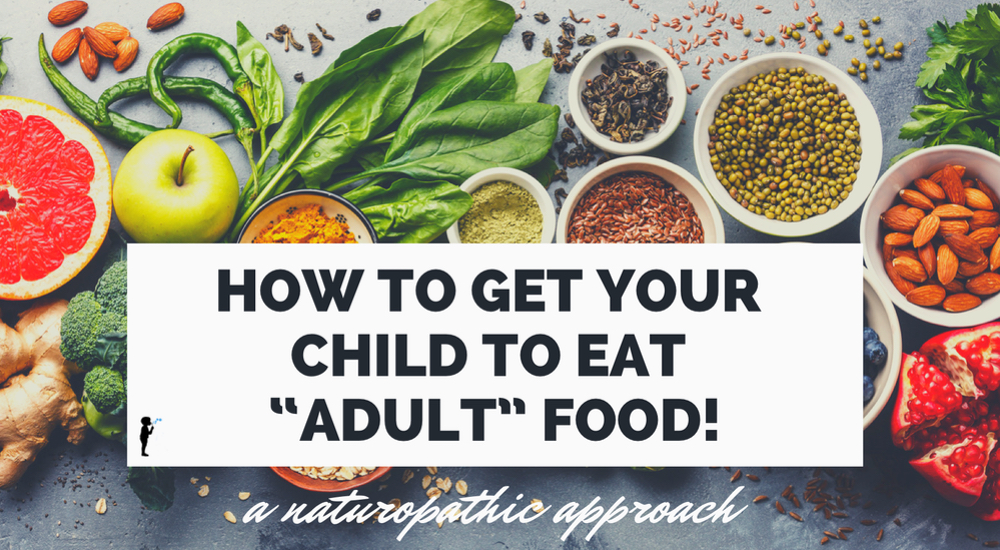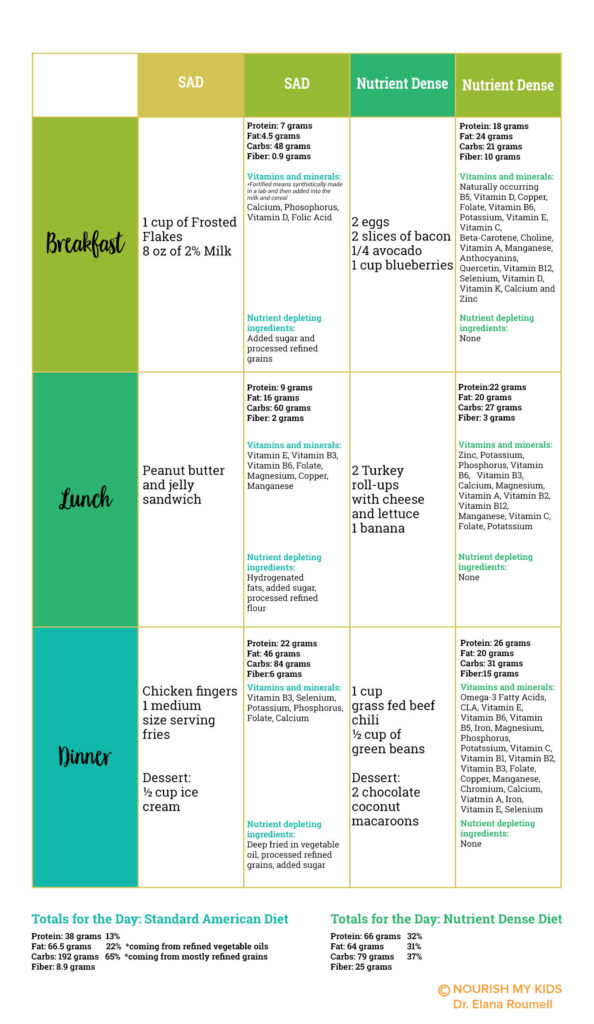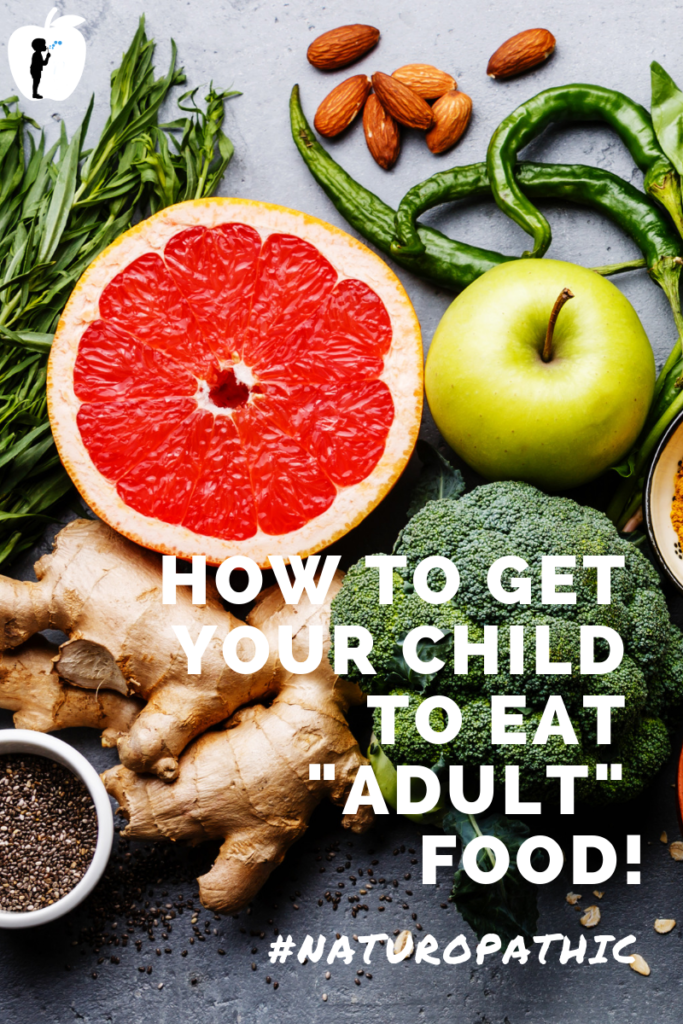
How To Get Your Child To Eat “Adult” Food!
The “Standard American Diet”
The classic American kids’ menu is generally the same at all restaurants: grilled cheese sandwich, chicken nuggets and fries, macaroni and cheese, or pizza, and a juice box. In far fewer restaurants, kids’ menus may provide apple slices or carrots. This is now becoming more common even of international cuisine where these typical Americanized “kid foods” are showing up on menus simply due to the the demand of what children are eating.
Moderation is a key nutritional tenet that holds true in almost all situations, and in this scenario we can say that yes, it is fine for your child to consume pizza or chicken nuggets every once in a while. But the problem is that the reason there are separate kid’s menus with these kinds of choices is because many children eat this food day in and day out, and simply will not eat or try anything else on the regular “adult” menu. While there are developmentally normal periods of picky eating throughout toddlerhood, my goal as a naturopathic doctor is to educate, empower, and inspire parents to help set their kids up with healthy eating habits from the start. Before we get into the “how,” let’s talk about WHY!
Fried, dairy-heavy, vegetable-less: three words to describe the majority of these types of foods. What this means to me: vegetable oils, GMO’s, and synthetic chemicals – oh my! We took the wrong road in the Land of Oz. Vegetable oil often serves as the base of which these foods are cooked, and at high heats they oxidize and change chemical structure, becoming trans fats. As processed foods, these menu items contain various genetically-modified and synthetic chemicals that are inherent to the manufacturing of processed foods.
So What Can We Do?
Feed our kids REAL WHOLE FOOD! When I first started my private practice I treated children and adults for general medicine. At that time, I created my Balanced Meal Guide and helped adults eat more healthfully with this easy to follow approach. When I transitioned my practice to seeing mostly pediatrics, I thought I needed to modify my handout specifically for kids. But then I caught myself! I almost fell into the same trap most parents do, thinking that children NEED a different menu and philosophy around eating, when they really do not! I started using the same meal guide handout for adults as I do with kiddos and found it to be of perfect use.
For a free download of this handout, visit our website Nourish Medical Center. Below is the outline of the handout four main meal must-haves that I teach to my patients – adults and kids alike.
- Healthy Protein
- Healthy Fat
- Vegetable
- Nutrient Dense Carbohydrate
For more information on these food categories (with examples!) check out the handout on my website, linked above. Making a complete plate at each meal may serve as a fun game for older kids. The game is to look at each part of their plate and identify which food falls in which category, as well as to make sure that all four categories are represented. If they are missing something, then their meal is not balanced and needs the missing piece! “Mom, I need a protein my plate is missing one!” Music to my ears!
While getting a child to actually eat the balanced meal may be tricky, keep trying. This is a very important time in your child’s life, and children require more nutrients than adults. They are growing beings with high metabolic demands for optimal bone development, brain capacity, neuron formation, organ maturation and so much more. All of these processes require proper nutrition. As adults, our brains have already grown to the maximum size, our organs are at full potential, and bones at maximum length – our body’s metabolic focus is on general maintenance and slowing the aging process. Kids, however, are BUILDING. The nutrition we set up for them now will help them grow into healthy adults that then go on to have healthy children of their own. It’s an opportunity to optimize epigenetic potential right before our eyes.
Using this four-part equation for a healthy meal makes cooking for the entire family easier, and lets you off the hook from becoming a short order cook. Everyone is eating the same meal and everyone is nourishing themselves healthfully.
Easier said than done right? How do you make the transition?
Education:
Make it fun! With the game mentioned above, letting them help choose items at the grocery store and cook with you, this can be an educational process for all. Growing a simple vegetable garden can be a very impactful practice for kiddos to see where exactly their food comes from, and to have some sense of accomplishment and control over the meal options by picking their harvest and enjoying it in a meal.
Meal Prepping:
Planning ahead of time is a MUST when cooking whole-foods meals for an entire family. If you don’t have healthy food on hand already prepared, it is much too easy to want to eat out, grab something quick (frozen, processed), or find yourself battling your child with food choices because everyone is overly hungry. Visit my Instagram page for my “Meal Prep Monday” ideas and follow #mealprepmamas
Go Slow:
Take it one day at a time. This is not going to be an overnight switch. Unfortunately, highly processed foods contain addictive components such as refined sugar or MSG. These foods can alter brain chemistry and suddenly – desires become perceived “needs.” Tantrums are likely when you change what they are used to eating. Remember, this is similar to an addict detoxing from drugs, and it gets worse before it gets better. There are a few ways to do this. You can choose to either slowly decrease the number of times your child eats these foods, or you can cut them off cold turkey, the choice is yours. Know that changing eating habits takes time and a certain level of learning curve to get over. You and your child will benefit greatly from this one, so keep going!
Don’t give in!
If your child is not underweight, then I recommend to my patients that they let their child go to bed hungry if they are denying what you are feeding them. Your child WILL get hungry enough at some point and will eat. Giving in will only prolong the transition to happen. Hang in there. It’s not easy at first but will pay off in the long run. If your child is underweight then speak with your doctor first before having your child skip meals. However, these kids are especially in need of nutrient dense foods so before you give in to the kid’s menu again because you are worried about your child being underweight, best to visit a doctor and look for the underlying cause to not being able to put on weight.
How does a typical “kids” diet compare to a whole foods diet?
Below is a table that compares a typical nutrient dense meal plan for the day and its nutrition, to a typical Standard American Diet (SAD diet). All these food opportunities add up (or down) to what could be a very healthful day overall. You will notice how nutrient dense foods include many vitamins and minerals while SAD foods include more nutrient depleting ingredients. By days end, these two different diets may total the same calories, but it sure isn’t the same nutrition for your growing little ones.

You can see how day in and day out, with habits formed deeper with each meal, our children are missing out on a significant amount of nutrition eating typical “kid food.” The SAD diet in this example contained too little protein, too many carbohydrates, and fats of poor quality. The goal is to offer them balanced meals made up of a combination of healthy proteins, fats, carbohydrates and veggies. Additionally, it is important to use good quality ingredients where possible, like organic produce and pastured or grass-fed meats.
Don’t be a short order cook. Serve your kids the same food you are eating and get in that routine! And yes, this means that you and the others in your household need to model healthy eating behaviors for your kiddos to learn from, as well! You got this!




Gabriel Suggate
March 2, 2019 at 6:05 pmhi there, I purchased two ebooks today (the Elimination diet and ADHD ebook) and I cannot find how to access these after I have downloaded a copy of the Elimination ebook only. How can I access this please? Sorry I can’t find where else to contact you.
Erika Krumbeck, ND
March 12, 2019 at 9:21 pmHi Gabriel, sorry for the delay, I was out of the country – I e-mailed you!
Erika
January 13, 2019 at 11:22 amNot sure if I’d recommend deli meats as part of a whole foods diet. Turkey slices and bacon? Really? What about the impact that has on long term colon cancer risk and cardiovascular disease?
Erika Krumbeck, ND
January 13, 2019 at 1:12 pmThere are lots of nitrate-free bacon and turkey options. Even still, matched with plenty of fruits, veggies or a vitamin C source, I doubt that would be a problem.
Jac
January 29, 2019 at 5:39 pmThere are umpteen quality bacon and turkey products available in the US. More than anywhere else. And making your own bacon with organic pastured pork is so easy. I add a teaspoon of smoked salt rather than smoking to make the process even easier.
https://www.smallfootprintfamily.com/how-to-cure-bacon